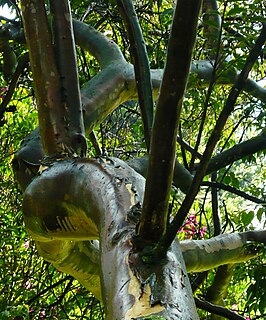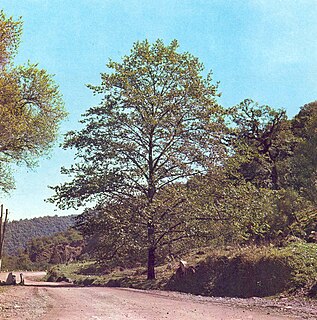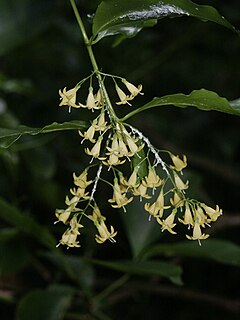Conceveiba is a plant genus of the family Euphorbiaceae, first described as a genus in 1775. It is native to South America and Central America.
- Conceveiba guianensisAubl. - Brazil, Peru, Bolivia, Ecuador, Colombia, Venezuela, 3 Guianas
- Conceveiba hostmaniiBenth. - Guyana, Suriname, Amazonas State in Brazil
- Conceveiba krukoffiiSteyerm. - Venezuela, French Guiana, NW Brazil
- Conceveiba latifoliaBenth. - Colombia, Venezuela, Peru, Amazonas State in Brazil
- Conceveiba martianaBaill. - Venezuela, French Guiana, NW Brazil, Colombia, Ecuador, Peru, Bolivia
- Conceveiba maynasensisSecco - Loreto in Peru
- Conceveiba parvifoliaMcPherson - Panama, NW Colombia
- Conceveiba pleiostemonaDonn.Sm. - Costa Rica, Nicaragua, Colombia, Venezuela
- Conceveiba praealta(Croizat) Punt ex J.Murillo - NW Brazil
- Conceveiba ptariana(Steyerm.) Jabl. - S Venezuela
- Conceveiba rhytidocarpaMüll.Arg. - Colombia, Ecuador, Peru
- Conceveiba santanderensisJ.Murillo - NW Colombia
- Conceveiba terminalis(Baill.) Müll.Arg. - Venezuela, Guyana, Suriname, NW Brazil, Colombia, Peru
- Conceveiba tristigmataJ.Murillo - Colombia, Venezuela, NW Brazil

Abolboda is a genus of flowering plants, traditionally and nowadays assigned to family Xyridaceae. It is native to South America and to the island of Trinidad, generally on marshy savanna.

Schoepfia is a genus of flowering plants belonging to the family Schoepfiaceae. The genus has long been placed in the Olacaceae family though many researchers noted the differences between it and the rest of the family. Recent molecular studies have shown Schoepfia to be more closely related to the families Misodendraceae and Loranthaceae, and to uphold the criteria of monophyly it must be excluded from Olacaceae.
Brewcaria is a genus of plants in the family Bromeliaceae. The genus is named for Charles Brewer-Carías, Venezuelan explorer and naturalist. It contains 6 known species, all native to Colombia and Venezuela.

Bactris setulosa is a medium-sized spiny palm which is found in Colombia, Venezuela, Ecuador, Peru, Trinidad and Tobago and Suriname. It is one of the largest species of Bactris and is found at the highest elevations.

Greigia is a genus of plants in the family Bromeliaceae, subfamily Bromelioideae. It is native to Latin America from Mexico to Chile. The genus is named in honour of Major General Samuel Alexjewitsch Greig, president of the Russian Horticultural Society in 1865.

Calycolpus is a genus of the botanical family Myrtaceae, first described as a genus in 1856. It is native to the South America, Central America, and the West Indies.

The South American common toad is a species complex of toads in the family Bufonidae. They are found throughout the Amazonian South America and eastern Panama. It was originally believed to be a single species, but is now known to represent a complex of more than one.
Hyloxalus fuliginosus is a species of frog in the family Dendrobatidae. It may be endemic to Ecuador where it is known from the Amazonian slopes of the Andes in the northern Ecuador, with some sources reporting it from Colombia and Venezuela.

Alnus acuminata is a species of deciduous tree in the Betulaceae family. It is found in montane forests from central Mexico to Argentina.
Greigia sodiroana is a species of plant in the family Bromeliaceae. It is endemic to Ecuador. Its natural habitats are subtropical or tropical moist montane forests and subtropical or tropical high-altitude shrubland. It is threatened by habitat loss.

Helicia is a genus of 110 species of trees and shrubs, constituting part of the plant family Proteaceae. They grow naturally in rainforests throughout tropical South and Southeast Asia, including India, Sri Lanka, Indochina, Peninsular Malaysia to New Guinea and as far south as New South Wales.

Neea is a genus of plants in family Nyctaginaceae from the Caribbean region, Central and South America. Members of the genus are commonly called Nia, Neea, or saltwood.

Chiococca is a genus of flowering plants in the family Rubiaceae. It currently holds 23 species that are native to Florida, Texas, Mexico, Central America, much of South America, the West Indies, and the islands of Galápagos and Fernando de Noronha.
Greigia columbiana is a plant species in the genus Greigia. This species is native to Costa Rica, Panama, Colombia, Ecuador, and Venezuela.
Greigia vulcanica is a species of flowering plant in the Bromeliaceae family. It is native to Colombia and Ecuador.

Tinantia is a genus of plants in the Commelinaceae, first described in 1839. They are commonly called widow's tears or false dayflowers due to their resemblance of the closely related true dayflowers of the genus Commelina. Tinantia is native to North and South America from Texas + Hispaniola to Argentina, with a center of diversity from Mexico to Nicaragua. Tinantia pringlei, an alpine native of Mexico, is grown as an ornamental in temperate areas and is also a common greenhouse weed.
Aratitiyopea is a monotypic genus of flowering plants, in the family Xyridaceae containing the single species Aratitiyopea lopezii. The genus was erected and described in 1984. This species is native to northern South America.

The biodiversity of Colombia is the variety of indigenous organisms in the country with the second-highest biodiversity in the world, behind Brazil. As of 2016, 56,343 species are registered in Colombia, of which 9,153 are endemic. The country occupies the first position worldwide in number of orchids and birds, second position in plants, amphibians, butterflies and fresh water fish, third place in species of palm trees and reptiles and globally holds the fourth position in biodiversity of mammals.











